Aug 18, 2021
The Upper East Side home of The Mount Sinai Hospital and the Icahn School of Medicine at Mount Sinai spans continuously from 101st St down to 98th Street, with other buildings arrayed nearby. To achieve this continuous campus, what had once been 99th and 100th Streets between Madison and Fifth Avenues have disappeared. How and when did that happen?

View along 100th St., around 1937
The Mount Sinai Hospital moved to 100th Street in 1904, taking up the whole block between the avenues and up to 101st Street. In 1911, the Hospital started buying lots on the south side of 100th Street in anticipation of a large expansion program. By 1921, those new buildings stretched from Fifth Avenue across but not quite to the end of 100th Street. The street was used for physician parking, and in December 1949, New York City deeded the bed of 100th Street to Mount Sinai. It continued as parking for a few more decades, but with the construction of the Guggenheim Pavilion starting in 1986, the street disappeared into a plaza between the original buildings and the new.
The story on 99th Street is very similar: Mount Sinai had expanded to having buildings spread along the northern side of the block. At the end of the 1950s, when construction of the Klingenstein Clinical Center (KCC), fronting onto the corner of Madison and 99th Street, was being planned, Mount Sinai sought the help of the City, and in August 1958, the road bed of 99th Street was deeded to Mount Sinai.
And what about the former streets? Once the construction on KCC was finished, this area became known as the Hospital Gardens, and graduation ceremonies for our School of Nursing, as well as special events were held out there. The plaza across 100th Street was covered in bricks, and a large sculpture called La Sfera Grande by Arnaldo Pomodoro was placed there in 1974. In the late 1960s, all of the buildings along the former southern side of 100th Street and the northern side of 99th Street were torn down to make way for the Annenberg Building. The Gardens became Ross Park, and today the Sfera Grande sits adjacent to the Nathan Cummings Atrium in the Guggenheim Pavilion. This is only appropriate since Mr. Cummings had originally given Mount Sinai the sculpture.

Nursing School graduation in the ‘Gardens’ in 1961. Note that KCC is being built in the back left of the image.
Nov 9, 2020
I recently read a piece about Hamilton Square in the Roosevelt Island Historical Society’s From the Archives email. This park, which was named for Alexander Hamilton, existed on the Upper East Side of Manhattan from around 1807-1869. I found this fascinating since The Mount Sinai Hospital moved to Lexington Ave. and 66th St. in 1872. I knew that the City had ‘seeded’ this area with non-profit entities: Hunter College, many hospitals and schools, but I had never heard about the Square itself, which ran from 66th to 69th Streets between 3rd and 5th Avenues. Finally, Mount Sinai had a Hamilton connection, even though he died in 1804, 48 years before the Hospital was created!
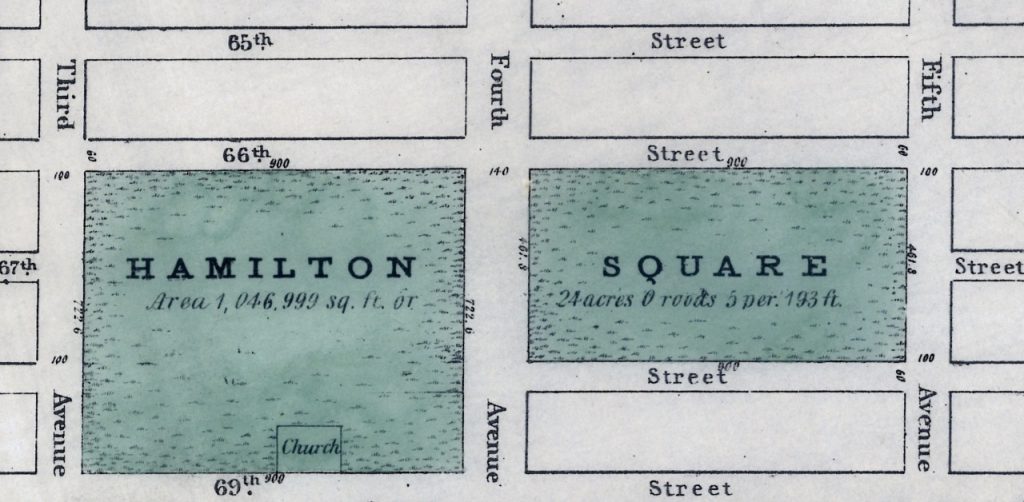
Map of Hamilton Square from the New-York Historical Society
When the Square was broken up, The Mount Sinai Hospital (MSH) was located on W. 28th Street, between 7th & 8th Avenues. It had been founded in 1852 as the Jews’ Hospital in the City of New York (the name was changed in 1866) and had opened its first building in 1855. After the Civil War, the leadership realized that the facility was inadequate and the location less than ideal due to the growth of the City. On November 2, 1867 the Directors authorized the purchase of ten lots of land from 65th to 66th Street on the west side of Park (then 4th) Ave. and later added eight more lots there. But then on October 6, 1868, the City leased Mount Sinai twelve lots of land between 66th and 67th on Lexington Ave. for $1 a year for 99 years. Somehow, over the interim, the City and Mount Sinai had reached an agreement on the Hospital taking over part of the former Hamilton Square. The earlier lots were later sold, saving Mount Sinai thousands of dollars. On May 25, 1870, the cornerstone for the second MSH was laid. The President of the Hospital, Benjamin Nathan, and Mayor Oakley Hall were there. (Within two months, Nathan was murdered in his bed on a ‘dark and stormy night.’)

On May 29, 1872, a dedication ceremony was held for the new Mount Sinai Hospital. When the building opened, it had a greatly expanded capacity of 110 beds. The building was designed by the well-known architect, Griffeth Thomas, and cost $335,000 to complete. It had an operating room in the basement of the north wards, rooms for our newly created House Staff to live in, a meeting room for the Directors, and a synagogue. Lexington Ave. remained unpaved for two more years, and the Hospital never wired the facility for electricity. A telephone was installed in 1882; the number was “Thirty-Ninth St., 257”. It was at this site that Mount Sinai transformed into what we would recognize as a modern hospital, with medical education and research joining its core mission of providing patient care.
In typical Mount Sinai fashion, this facility quickly became too small. Additional buildings were built and major renovations were begun in 1882. In 1890, Mount Sinai added a building across from the Hospital on the north side of 67th St. for our nursing school and Out Patient Department. This building is the only remnant of Mount Sinai that remains there today. It later served as the home of the Neurological Institute, the Polish legation, and finally became a school for the Archdiocese of NY. The Mount Sinai Hospital moved from Lexington Ave. in 1904 to its current East Side location on 100th St., between Madison and 5th Avenues. The name of Hamilton continues on various buildings and neighborhoods of the City, making its most recent appearance on Broadway.
May 18, 2018
By some remarkable coincidence, many Mount Sinai Health System buildings have been dedicated or opened in May.
The Beth Israel Hospital opened its first facility in a rented loft in May 1890 and then moved to 196 Broadway the next year. In May of 1892 they moved again, this time to 206 E. Broadway and 195 Division St. Beth Israel remained at this location until the completion of the Jefferson & Cherry Street building in 1902. Beth Israel did not have another May opening until May 15, 1966 when the Linsky Pavilion opened.
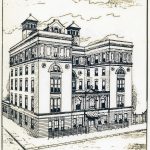
Beth Israel’s Jefferson and Cherry Street location

The Linsky Pavilion, which opened in May 1966
On May 17, 1855, a religious service was held to inaugurate the opening of The Jews’ Hospital in the City of New York, which became The Mount Sinai Hospital in 1866. Presiding at the inauguration was Rabbi J.J. Lyons, with Rabbis Leo, Sternberger, Rubin, Cohen, Waterman, Schickler and Tebrich serving as cantors.

The original building of The Mount Sinai Hospital

The second site of the Hospital
When Mount Sinai had outgrown this site, the Trustees decided to move uptown to the block of Lexington Avenue between 66th and 67th Streets. The cornerstone for the new hospital was laid on May 25, 1870 and the completed hospital was opened on May 29, 1872.

The 1904 building along 100th Street
Within 25 years, the Hospital had again filled its site and decided to move to its current home next to Central Park, between 100th and 101st Streets. The Park ensured that the hospital would not again get surrounded by the bustle of the City’s streets. The cornerstone for this new hospital was laid on May 22, 1901. In May 1922, Mount Sinai marked the completion of a massive expansion project that extended the hospital across 100th Street down to 99th Street. This included 1184 5th Avenue, which today is the oldest building on the Mount Sinai campus.
On May 23, 1952, The Mount Sinai Hospital celebrated the dedication of the Klingenstein Pavilion on 5th Avenue.
This was built as Mount Sinai’s Maternity Pavilion, and remains the home of our OB-GYN department. At the same event, the Atran Laboratory and the Henry W. Berg, MD Laboratory buildings were both dedicated as well.

The Klingenstein Pavilion on 5th Avenue

Vice President Ford and Walter Annenberg looking at the portrait of Mrs. Annenberg at the dedication in 1974
And finally, in perhaps Mount Sinai’s biggest dedication, on May 26, 1974, the new Mount Sinai School of Medicine welcomed Vice President Gerald Ford and the Annenberg family to celebrate the formal dedication of the Annenberg Building. When this building opened, it was the thought to be the largest space in this country devoted to medical education.
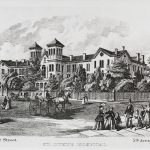
St. Luke’s Hospital on 5th Avenue
The Mount Sinai Hospital was not alone in its fascination with May for buildings. On May 21, 1857, the St. Luke’s Hospital chapel opened at the Hospital’s first site and a year later (May 13, 1858) the hospital itself opened at 5th Ave between 54th and 55th Streets.
The Woman’s Hospital in the State of New York, which became the Women’s Division of St. Luke’s Hospital in 1952, also had a May dedication tradition. On May 4, 1855 the Woman’s Hospital was opened at 83 Madison Avenue. Almost 50 years later, on May 17, 1904, the cornerstone was laid at a new site at Amsterdam Avenue and 110th Street.

The first home of the Woman’s Hospital

The 1904 west side Woman’s Hospital building
Finally, on May 25, 1965 the Woman’s Hospital opened in a separate building on the St. Luke’s campus on Amsterdam Avenue and 114th Street.
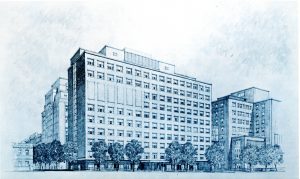
Mar 8, 2016
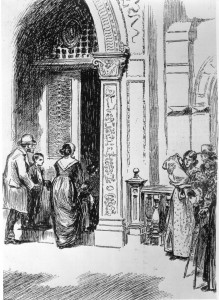
The entry to the Mount Sinai dispensary building where Dr. Welt served as chief of a pediatric clinic. This building on East 67th Street opened in 1890. In 1904 Dr. Welt moved with the clinic to the corner of Madison Avenue and 100th Street.
In honor of International Women’s Day, celebrated on March 8th, the Mount Sinai Archives wants to highlight a woman who is not remembered today, but who made a big impact on The Mount Sinai Hospital, Sara Welt Kakels, MD. Dr. Welt (1860-1943) was born in Czernowitz, Bukovina. She was one of four sisters, three of whom became physicians and the fourth a chemist. Sara Welt received her medical degree from the University of Zurich in 1885 and moved to New York City shortly thereafter to be with her sister, Dr. Rosa Welt Strauss, an ophthalmologist who also taught at The Mount Sinai Hospital School of Nursing.
In 1887, Dr. Welt was appointed to replace Mary Putnam Jacobi as one of the four heads of the Pediatrics clinics at the Hospital. She remained in charge of the clinic while she built a private practice in the community. In 1922 Sara Welt was the first woman to be appointed to the rank of Adjunct Pediatrician at Mount Sinai. She stepped down from active service in 1926 but remained closely affiliated with the Pediatrics Department until her death in 1943, at which time she bequeathed nearly $1,000,000 to Mount Sinai to establish the Sara Welt Memorial Fund, which established the Welt Fellowship program for young physicians who needed financial help, and also provided support of the Pediatric Clinic.
Dr. Welt married Moses S. Kakels, MD, a surgeon at the Mount Sinai clinics but primarily affiliated with Lebanon Hospital. Dr. Welt was very involved in teaching. She held appointments at the Women’s Medical College of the New York Infirmary, where she was an Instructor in the Practice of Medicine. She also lectured at The Mount Sinai Training School for Nurses on Anatomy and Physiology. She was an active member of The New York Academy of Medicine, as well as the New York Pathological Society. She had a pioneering interest in pediatric gynecology, and published over 20 articles on this and other topics.
When she died in 1943, the American Jewish Yearbook noted her final benevolence:
WELT-KAKELS, SARA (MRS. MOSES S. KAKELS), pediatrician Mt. Sinai Hosp., New York, N. Y., (d. Dec. 26, 1943), bequeathed to N. Y. Academy of Medicine $100,000 for aid of sick and needy physicians, $10,000 for lectureship by a pediatrician, and $20,000 for books and literature for library; $20,000 to Lebanon Hosp. for fellowship in surgery in honor of her husband; $10,000 to Hampton (Va.) Normal Agricultural Institute for establishment of four scholarships; and residuary estate, valued at $874,222, to Mt. Sinai Hosp., to set up “The Sara Welt Memorial Fund” ” and establish six traveling fellowships; reptd Feb. 6, 1946.
Sara Welt Fellows continued at The Mount Sinai Hospital for decades. Her support of these young doctors allowed her to touch the lives of thousands of patients.
Nov 19, 2015
November 18th is World Toilet Day, a phrase that seems strange – and funny! – to the ears. So, first some fun. Below are images of the fancy new bathroom, including a toilet, that Mount Sinai Hospital offered to the well-to-do paying patients in the new Private Pavilion that opened in 1921. It does not look like much today, but it had all the pieces and could be kept ‘sanitary,’ which was an important goal.
Which leads to the unfunny part about World Toilet Day. It exists for a reason. As the website for World Toilet Day notes: “Of the world’s seven billion people, 2.4 billion people do not have improved sanitation. 1 billion people still defecate in the open. Poor sanitation increases the risk of disease and malnutrition, especially for women and children.” (http://www.worldtoiletday.info/about)
Think about it, and go to the website to learn more.
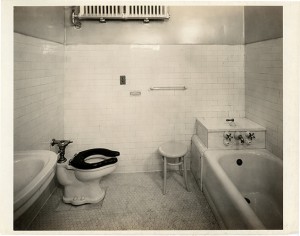

For more on the Archives or the history of Mount Sinai, contact us at msarchives@mssm.edu


















